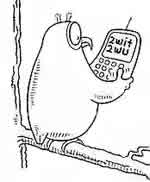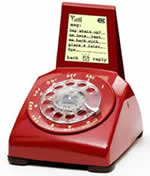
Students at Howe Public Schools are not to have
cell phones turned on between 8 AM and 2:45 PM.

Links related to SMS:
A recent AP poll showed that cell phone and text messaging usage is greatest among those between 18 and 29 years of age. Text messaging is the number one use of cell phones by young people. The number drops off by more than half in the age range between 30 and 49. The number of people over the age of 50 who are "texting" is very small indeed. While the poll did not survey anyone under the age of 18, it is obvious that the only thing limiting texting in this age group is their access to a cell phone.
For teenagers, texting is like knowing another language. Since it is an online language, it is global in nature and is quickly becoming a universal from of English. While everyone agrees that language evolves, there are groups of highly educated people who are dead set against the presence of texting in schoolwork and who are arguing for ways to stamp it out. Other educators are encouraging students to use this style of writing, especially in "first drafts" of school work. It is the position of this group that anything that encourages young people to write must have some value.
According to Nielson/Net Ratings, 60% of the online population under age 17 uses text messages. They use it primarily to socialize and communicate, in other words, for recreation. There is a culture associated with this style of writing, and that culture is important and meaningful to our youths.
Teenagers have long pushed the boundaries of spoken language, now they are pushing the boundaries of written language. Youths like the feeling of knowing something that not everyone knows and sharing that with their friends. The Internet and online communication is very real for them, they don't see it as a technological revolution...they're actively using it everyday.
Some basic text lingo "rules":
- Take Out Vowels - A simple method of shortening words is to eliminate some of the vowels. For example, shorten 'TEXT' to 'TXT'.
- Replace Words with Symbols and Numbers - For example, instead of writing the word 'FOR', use the number '4'. Also, whenever the letters 'FOR' appear as part of another word like 'FORGIVE', substitute the number for the word and write '4GIVE'.
- Replace 'I' with 'Y' - For many words, it is possible to replace an 'I' with a 'Y' and remove some characters from the word. With the word 'RIGHT', replace the 'I' with 'Y' and remove the 'G' and 'H' to make 'RYT'.
- Use Sounds to Represent Words - For example, instead of writing 'YOU', replace it with the letter which creates the same sound, 'U'. For the word 'WHY', replace it with 'Y' and for the word 'ANY' replace it with 'NE'.
- Use Known Abbreviations and Common Words - There are some words that do not use the regular methods above but have become popular abbreviations or acronyms over time. Many of these have spread to text messages from their initial use in chat rooms over the Internet.
- Combine all the Methods Above - Combining methods is an important part of text messages. An example of combining words is the word 'ANYONE'. By using the method of sounds and the method of replacing words with symbols and numbers, the word 'ANYONE' becomes 'NE1'.
1528 students from a metropolitan area with four high schools were surveyed. The sample was comprised of 52% males and 48% females, whose ages ranged between 12 and 19 years. The average overall for both genders was 15 years old.
|
|
A texting device this webmaster MIGHT be able to use! |

|
|---|